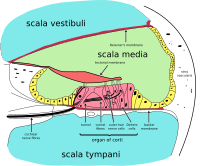
Photo from wikipedia
The mammalian cochlea contains three rows of outer hair cells (OHCs) that amplify the basilar membrane traveling wave with high gain and exquisite tuning. The pattern of OHC loss caused… Click to show full abstract
The mammalian cochlea contains three rows of outer hair cells (OHCs) that amplify the basilar membrane traveling wave with high gain and exquisite tuning. The pattern of OHC loss caused by typical methods of producing hearing loss in animal models (noise, ototoxic exposure, or aging) is variable and not consistent along the length of the cochlea. Thus, it is difficult to use these approaches to understand how forces from multiple OHCs summate to create normal cochlear amplification. Here, we selectively removed the third row of OHCs and Deiters' cells in adult mice and measured cochlear amplification. In the mature cochlear epithelia, expression of the Wnt target gene Lgr5 is restricted to the third row of Deiters' cells, the supporting cells directly underneath the OHCs. Diphtheria toxin administration to Lgr5DTR-EGFP/+ mice selectively ablated the third row of Deiters' cells and the third row of OHCs. Basilar membrane vibration in vivo demonstrated disproportionately lower reduction in cochlear amplification by about 13.5 dB. On a linear scale, this means that the 33% reduction in OHC number led to a 79% reduction in gain. Thus, these experimental data describe the impact of reducing the force of cochlear amplification by a specific amount. Furthermore, these data argue that because OHC forces progressively and sequentially amplify the traveling wave as it travels to its peak, the loss of even a relatively small number of OHCs, when evenly distributed longitudinally, will cause a substantial reduction in cochlear amplification.
Journal Title: Journal of neurophysiology
Year Published: 2022
Link to full text (if available)
Share on Social Media: Sign Up to like & get
recommendations!